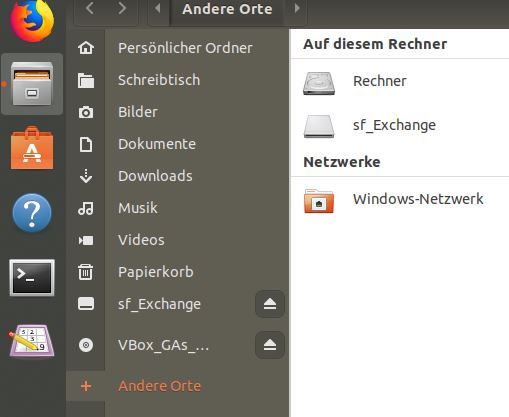NEWS
MaxCul Probleme kann HM Geräte nicht verbinden
-
@Lucy_Wolf sagte:
ich habe nur vergessen wie man navigiert
cd /etc/homegear nano main.confnano ist der Editor.
-
nicht Navigieren zu können
Hat Dein Ubuntu keine graphische Oberfläche ?

Dateien -> Andere Orte -> Rechner
-
@paul53 ne ist genau ubuntu server, ja war eine doffe idee, wenn ich ein pi4 habe, wirt alles auch besser laufen und weis wie alles läuft und gemacht werden muss
-
-
GNU nano 2.9.3 main.conf Homegear configuration file See for more details: https://doc.homegear.eu/data/homegear/configuration.html#main-configuration-main-conf Default: runAsUser = root runAsUser = homegear Default: runAsGroup = root runAsGroup = homegear Set the debug log level 0=none, 1=critical, 2=error, 3=warning, 4=info, 5=debug, >5=more debug information Default: 4 debugLevel = 4 Default: memoryDebugging = false memoryDebugging = true Prints log information helping in fixing errors Default: devLog = false devLog = false Logs all IPC communication to a PCAP file Default: ipcLog = false ipcLog = false Set to false to disable core dumps. Currently to make fixing errors easier, core dumps are enabled by default. Default: enableCoreDumps = true enableCoreDumps = true If set to true Homegear sets permissions on devices and GPIOs on start. On some systems that might not be desirable or necessary. If Homegear is part of all groups that have access to the needed devices, you can savely set this setting to false. Default: setDevicePermissions = true setDevicePermissions = true The working directory of Homegear. E. g. core dumps are written here. If workingDirectory is empty, the executable path is used. Default: workingDirectory = workingDirectory = /var/lib/homegear The socket files are placed into this directory. If socketPath is empty, the executable path is used. Default: socketPath = socketPath = /var/run/homegear If dataPath is empty, the executable path is used. Default: dataPath = dataPath = /var/lib/homegear -
@Lucy_Wolf
Ich denke, das kann man so lassen. Bitte das nächste Mal den Inhalt in Code tags posten. -
GNU nano 2.9.3 # Homegear configuration file # See for more details: https://doc.homegear.eu/data/homegear/configuration.html#main-configuration- # Default: runAsUser = root # runAsUser = homegear # Default: runAsGroup = root # runAsGroup = homegear # Set the debug log level # 0=none, 1=critical, 2=error, 3=warning, 4=info, 5=debug, >5=more debug information # Default: 4 debugLevel = 4 # Default: memoryDebugging = false memoryDebugging = true GNU nano 2.9.3 rpcclients.conf # rpcclients.conf # # In this file you can define security settings for your XML RPC clients # # The name between the square brackets is arbitrary [ExampleClient1] # For security reasons you should always use the hostname here. Otherwise # the certificate verification doesn't work and Homegear might send you # client's password to an unauthorized client. # "hostname" must be specified. It is used to identify the client. hostname = myHostName # The path to the certificate authority's certificate caFile = /path/to/ca-certficate # verifyCertificate checks if the server certificate received by the # XML RPC client from the XML RPC event server is signed by one of the # root CAs in /etc/ssl/certs. If you use a self signed certificate, # please put your root certificate in that directory. Only disable the # verification for testing purposes. Without verification any attacker # can pose as your XML RPC event server. # Default: verifyCertificate = true verifyCertificate = true # For security reasons always set "forceSSL to true when the client supports # SSL, especially when authentification is being used. Otherwise Homegear # might send your clients password to an unauthorized client. # Default: forceSSL = true forceSSL = true -
@paul53 ich bekomme es noch hin lol
danke für den hinweis^^
-
@paul53 muss ich darin was ändern
-
@Lucy_Wolf sagte:
muss ich darin was ändern
hostname solltest Du ändern. Zu SSL und Zertifikaten kann ich nichts sagen (bin kein ITler).
-
@paul53 den hostname ist dann das wie der heißen soll ?
würde dann es homegear nennen
-
@Lucy_Wolf
Es gibt ein deutschsprachiges Homegear-Forum. -
@paul53 naja sind scheinbar fast durch
ip lass ich vom router vergeben, kann ich dann am router festlegen
mqtt lass ich so -
ip lass ich vom router vergeben
Das ist die IP-Adresse von Ubuntu. Homegear und ioBroker kommunizieren über localhost (127.0.0.1).
@Lucy_Wolf sagte in MaxCul Probleme kann HM Geräte nicht verbinden:
mqtt lass ich so
Ja, MQTT wird nicht benötigt.
-
@paul53 bei 10.1. Main Configuration muss ich auch noch durch oder?
-
@Lucy_Wolf
Die Voreinstellungen sollten passen. -
@paul53 wie starte ich das jetzt oder leuft das jetzt schon
-
@Lucy_Wolf sagte:
wie starte ich das jetzt oder leuft das jetzt schon
Keine Ahnung

Laut Homegear Grundlagen soll es nach der Installation schon laufen.Nach der Installation läuft Homegear als Dienst im Hintergrund. Mittels sudo service homegear restart kann der Dienst bei Bedarf - zum Beispiel nach Änderungen an den Konfigurationsdateien - neu gestartet werden.
-
@paul53 im router ist jedenfall nix neues dazu gekommen
-
@Lucy_Wolf sagte:
im router ist jedenfall nix neues dazu gekommen
Wie auch ? ioBroker und Homegear laufen unter dem gleichen Ubuntu. Oder läuft ioBroker im Container ?
Übrigens: Zum Anlernen und Konfigurieren der Geräte empfehle ich das Windows-Tool HomeMatic-Konfigurator, das ich auch verwende. Unter Einstellungen muss "Entfernter BidCos-Service" ausgewählt werden und die Ubuntu-IP-Adresse angegeben werden.